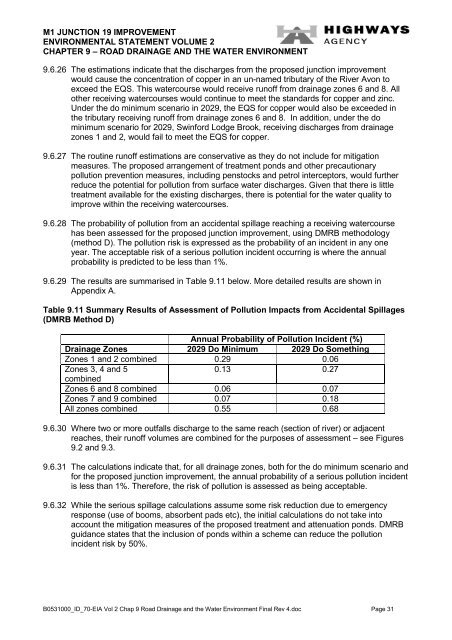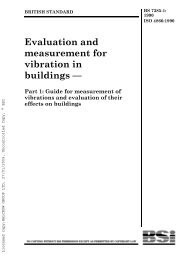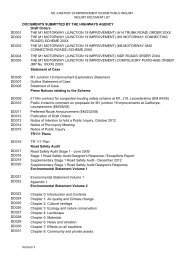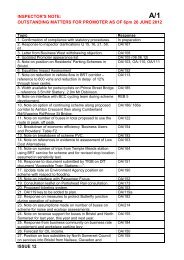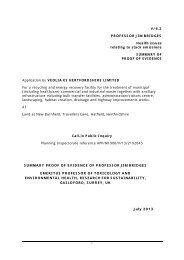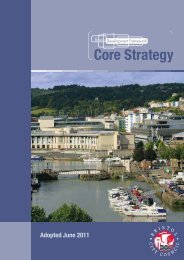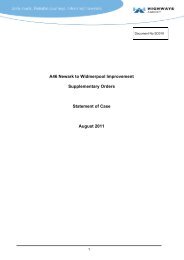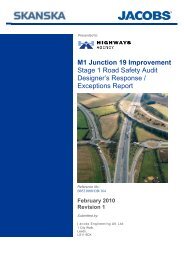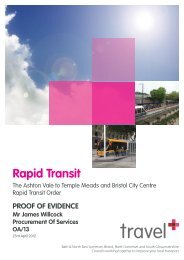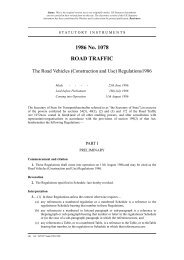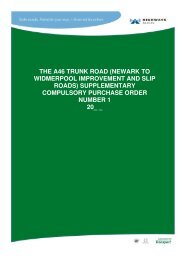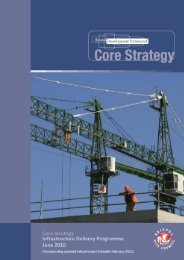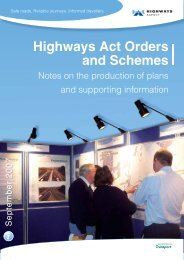Chapter 9: Road drainage and the water environment
Chapter 9: Road drainage and the water environment
Chapter 9: Road drainage and the water environment
You also want an ePaper? Increase the reach of your titles
YUMPU automatically turns print PDFs into web optimized ePapers that Google loves.
M1 JUNCTION 19 IMPROVEMENT<br />
ENVIRONMENTAL STATEMENT VOLUME 2<br />
CHAPTER 9 – ROAD DRAINAGE AND THE WATER ENVIRONMENT<br />
9.6.26 The estimations indicate that <strong>the</strong> discharges from <strong>the</strong> proposed junction improvement<br />
would cause <strong>the</strong> concentration of copper in an un-named tributary of <strong>the</strong> River Avon to<br />
exceed <strong>the</strong> EQS. This <strong>water</strong>course would receive runoff from <strong>drainage</strong> zones 6 <strong>and</strong> 8. All<br />
o<strong>the</strong>r receiving <strong>water</strong>courses would continue to meet <strong>the</strong> st<strong>and</strong>ards for copper <strong>and</strong> zinc.<br />
Under <strong>the</strong> do minimum scenario in 2029, <strong>the</strong> EQS for copper would also be exceeded in<br />
<strong>the</strong> tributary receiving runoff from <strong>drainage</strong> zones 6 <strong>and</strong> 8. In addition, under <strong>the</strong> do<br />
minimum scenario for 2029, Swinford Lodge Brook, receiving discharges from <strong>drainage</strong><br />
zones 1 <strong>and</strong> 2, would fail to meet <strong>the</strong> EQS for copper.<br />
9.6.27 The routine runoff estimations are conservative as <strong>the</strong>y do not include for mitigation<br />
measures. The proposed arrangement of treatment ponds <strong>and</strong> o<strong>the</strong>r precautionary<br />
pollution prevention measures, including penstocks <strong>and</strong> petrol interceptors, would fur<strong>the</strong>r<br />
reduce <strong>the</strong> potential for pollution from surface <strong>water</strong> discharges. Given that <strong>the</strong>re is little<br />
treatment available for <strong>the</strong> existing discharges, <strong>the</strong>re is potential for <strong>the</strong> <strong>water</strong> quality to<br />
improve within <strong>the</strong> receiving <strong>water</strong>courses.<br />
9.6.28 The probability of pollution from an accidental spillage reaching a receiving <strong>water</strong>course<br />
has been assessed for <strong>the</strong> proposed junction improvement, using DMRB methodology<br />
(method D). The pollution risk is expressed as <strong>the</strong> probability of an incident in any one<br />
year. The acceptable risk of a serious pollution incident occurring is where <strong>the</strong> annual<br />
probability is predicted to be less than 1%.<br />
9.6.29 The results are summarised in Table 9.11 below. More detailed results are shown in<br />
Appendix A.<br />
Table 9.11 Summary Results of Assessment of Pollution Impacts from Accidental Spillages<br />
(DMRB Method D)<br />
Annual Probability of Pollution Incident (%)<br />
Drainage Zones 2029 Do Minimum 2029 Do Something<br />
Zones 1 <strong>and</strong> 2 combined 0.29 0.06<br />
Zones 3, 4 <strong>and</strong> 5<br />
0.13 0.27<br />
combined<br />
Zones 6 <strong>and</strong> 8 combined 0.06 0.07<br />
Zones 7 <strong>and</strong> 9 combined 0.07 0.18<br />
All zones combined 0.55 0.68<br />
9.6.30 Where two or more outfalls discharge to <strong>the</strong> same reach (section of river) or adjacent<br />
reaches, <strong>the</strong>ir runoff volumes are combined for <strong>the</strong> purposes of assessment – see Figures<br />
9.2 <strong>and</strong> 9.3.<br />
9.6.31 The calculations indicate that, for all <strong>drainage</strong> zones, both for <strong>the</strong> do minimum scenario <strong>and</strong><br />
for <strong>the</strong> proposed junction improvement, <strong>the</strong> annual probability of a serious pollution incident<br />
is less than 1%. Therefore, <strong>the</strong> risk of pollution is assessed as being acceptable.<br />
9.6.32 While <strong>the</strong> serious spillage calculations assume some risk reduction due to emergency<br />
response (use of booms, absorbent pads etc), <strong>the</strong> initial calculations do not take into<br />
account <strong>the</strong> mitigation measures of <strong>the</strong> proposed treatment <strong>and</strong> attenuation ponds. DMRB<br />
guidance states that <strong>the</strong> inclusion of ponds within a scheme can reduce <strong>the</strong> pollution<br />
incident risk by 50%.<br />
B0531000_ID_70-EIA Vol 2 Chap 9 <strong>Road</strong> Drainage <strong>and</strong> <strong>the</strong> Water Environment Final Rev 4.doc Page 31


